[Latest Microsoft Certification Center] Most Accurate Microsoft 70-411 Dumps Windows Server Exam Download Latest Version PDF&VCE Youtube Training
Which Microsoft 70-411 dumps certification is better to start with for fresher? The Administering Windows Server 2012 (70-411 Windows Server) exam is a 234 questions assessment in pass4itsure that is associated with the MCP, MCSA, MCSE certification. Most accurate Microsoft 70-411 dumps Windows Server exam download latest version pdf&vce Youtube training. “Administering Windows Server 2012” is the exam name of Pass4itsure Microsoft 70-411 dumps test which designed to help candidates prepare for and pass the Microsoft 70-411 exam. Pass4itsure Microsoft 70-411 dumps exam training materials is the best training materials. If you’re also have an IT dream. Then go to buy Pass4itsure’s Microsoft https://www.pass4itsure.com/70-411.html dumps exam training materials, it will help you achieve your dreams.
[Latest Microsoft 70-412 Dumps Certification Center From Google Drive]: https://drive.google.com/open?id=0BwxjZr-ZDwwWTVhyb3I4T3F4blE
[Latest Microsoft 70-414 Dumps Certification Center From Google Drive]: https://drive.google.com/open?id=0BwxjZr-ZDwwWT1R2UXFwcFMwZEE
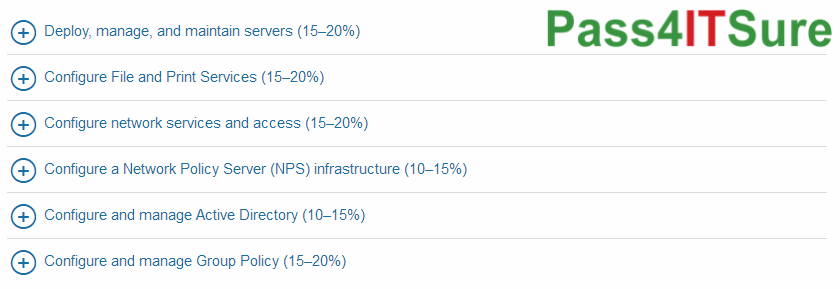
Up to the immediate present Microsoft 70-411 dumps exam cram:
Question No : 1 DRAG DROP – (Topic 0) Your network contains an Active Directory forest named contoso.com. The forest contains a Network Policy Server (NPS) server named NPS1 and a VPN server named VPN1. VPN1 forwards all authentication requests to NPS1. A partner company has an Active Directory forest named adatum.com. The adatum.com
forest contains an NPS server named NPS2. You plan to grant users from adatum.com VPN access to your network. You need to authenticate the users from adatum.com on VPN1. What should you create on each NPS server? To answer, drag the appropriate objects to the correct NPS servers. Each object may be used once, more than once, or not at all. You may need to drag the split bar between panes or scroll to view content.
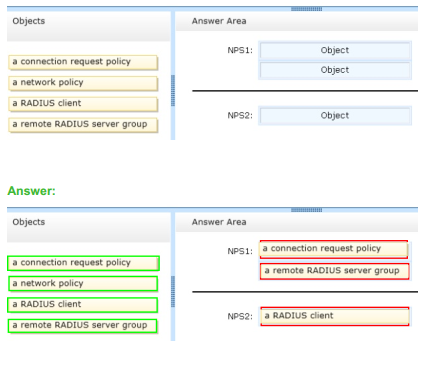
Question No : 2 HOTSPOT – (Topic 0) Your network contains an Active Directory domain named contoso.com. The domain contains the users shown in the following table.
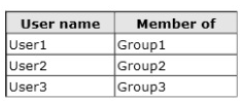
You have a Network Policy Server (NPS) server that has the network policies shown in the following table.

User1, User2, and User3 plan to connect to the network by using a VPN. You need to identify which network policy will apply to each user. What should you identify? To answer, select the appropriate policy for each user in the answer area.
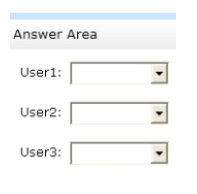
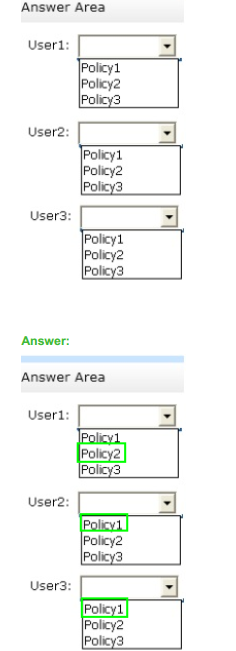
Question No : 3 – (Topic 0)
Your network contains an Active Directory domain named contoso.com. The domain contains a server named Server1 that runs Windows Server 2012 R2. Server1 has the following role services installed: DirectAccess and VPN (RRAS) Network Policy Server Remote users have client computers that run either Windows XP, Windows 7, or Windows 8. You need to ensure that only the client computers that run Windows 7 or Windows 8 can establish VPN connections to Server1. What should you configure on Server1?
A. A condition of a Network Policy Server (NPS) network policy
B. A constraint of a Network Policy Server (NPS) network policy
C. a condition of a Network Policy Server (NPS) connection request policy
D. A vendor-specific RADIUS attribute of a Network Policy Server (NPS) connection request policy
70-411 exam Answer: A
Explanation:
If you want to configure the Operating System condition, click Operating System, and then click Add. In Operating System Properties, click Add, and then specify the operating system settings that are required to match the policy. The Operating System condition specifies the operating system (operating system version or service pack number), role (client or server), and architecture (x86, x64, or ia64) required for the computer configuration to match the policy.
Question No : 4 HOTSPOT – (Topic 0) Your network contains an Active Directory domain named contoso.com. The domain
contains two servers named Server1 and Server2. Server1 has the Network Policy Server server role installed. Server2 has the DHCP Server server role installed. Both servers run Windows Server 2012 R2. You are configuring Network Access Protection (NAP) to use DHCP enforcement. You configure a DHCP scope as shown in the exhibit. (Click the Exhibit button.)
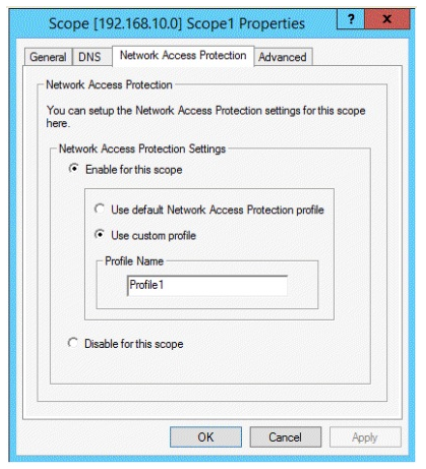
You need to ensure that non-compliant NAP clients receive different DHCP options than compliant NAP clients. What should you configure on each server? To answer, select the appropriate options for each server in the answer area.
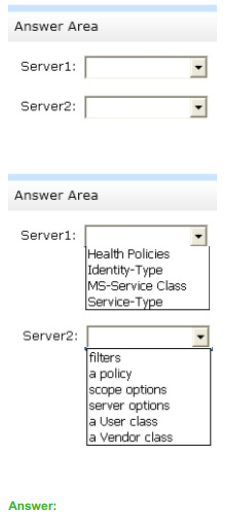
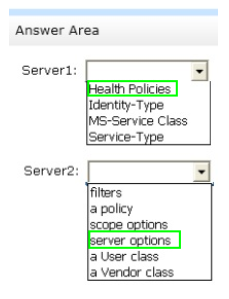
Question No : 5 – (Topic 0) You are a network administrator of an Active Directory domain named contoso.com. You have a server named Server1 that runs Windows Server 2012 R2. Server1 has the DHCP Server server role and the Network Policy Server role service installed. You enable Network Access Protection (NAP) on all of the DHCP scopes on Server1. You need to create a DHCP policy that will apply to all of the NAP non-compliant DHCP clients. Which criteria should you specify when you create the DHCP policy?
A. The client identifier
B. The user class
C. The vendor class
D. The relay agent information
70-411 dumps Answer: B
Explanation:
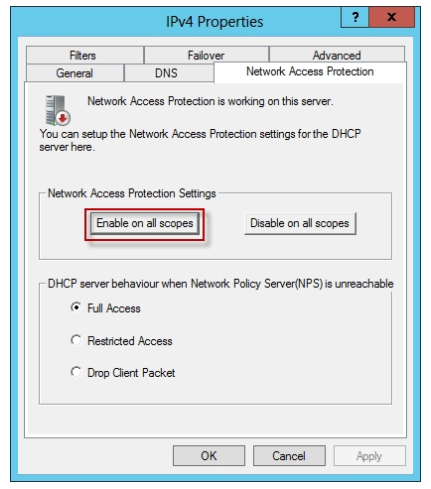
To configure a NAP-enabled DHCP server On the DHCP server, click Start, click Run, in Open, type dhcpmgmt. smc, and then press ENTER. In the DHCP console, open <servername>\IPv4. Right-click the name of the DHCP scope that you will use for NAP client computers, and then click Properties. On the Network Access Protection tab, under Network Access Protection Settings, choose Enable for this scope, verify that Use default Network Access Protection profile is selected, and then click OK. In the DHCP console tree, under the DHCP scope that you have selected, right click Scope Options, and then click Configure Options. On the Advanced tab, verify that Default User Class is selected next to User class. Select the 003 Router check box, and in IP Address, under Data entry, type the IP address for the default gateway used by compliant NAP client computers, and then click Add. Select the 006 DNS Servers check box, and in IP Address, under Data entry, type the IP address for each router to be used by compliant NAP client computers, and then click Add. Select the 015 DNS Domain Name check box, and in String value, under Data entry, type your organization’s domain name (for example, woodgrovebank. local), and then click Apply. This domain is a full-access network assigned to compliant NAP clients. On the Advanced tab, next to User class, choose Default Network Access Protection Class. Select the 003 Router check box, and in IP Address, under Data entry, type the IP address for the default gateway used by noncompliant NAP client computers, and then click Add. This can be the same default gateway that is used by compliant NAP clients. Select the 006 DNS Servers check box, and in IP Address, under Data entry, type the IP address for each DNS server to be used by noncompliant NAP client computers, and then click Add. These can be the same DNS servers used by compliant NAP clients. Select the 015 DNS Domain Name check box, and in String value, under Data entry, type a name to identify the restricted domain (for example, restricted. Woodgrovebank. local), and then click OK. This domain is a restricted-access network assigned to noncompliant NAP clients. Click OK to close the Scope Options dialog box. Close the DHCP console.
Question No : 6 HOTSPOT – (Topic 0) Your network contains a RADIUS server named Server1. You install a new server named Server2 that runs Windows Server 2012 R2 and has Network Policy Server (NPS) installed. You need to ensure that all accounting requests for Server2 are forwarded to Server1. On Server2, you configure a Connection Request Policy. What else should you configure on Server2? To answer, select the appropriate node in the answer area.
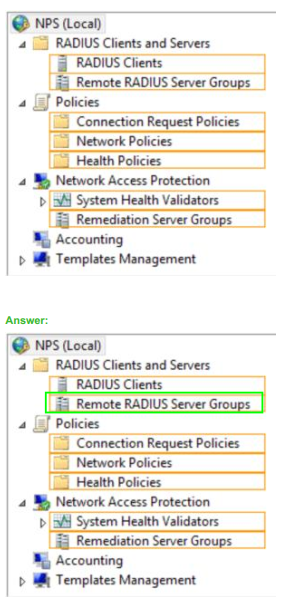
Question No : 7 – (Topic 0) Your network contains an Active Directory domain named contoso.com. The domain contains a server named Server1 that runs Windows Server 2012 R2 and has the Network Policy Server role service installed. An administrator creates a RADIUS client template named Template1. You create a RADIUS client named Client1 by using Template 1. You need to modify the shared secret for Client1. What should you do first?
A. Configure the Advanced settings of Template1.
B. Set the Shared secret setting of Template1 to Manual.
C. Clear Enable this RADIUS client for Client1.
D. Clear Select an existing template for Client1.
70-411 pdf Answer: D
Explanation:
Clear checkmark for Select an existing template in the new client wizard. In New RADIUS Client, in Shared secret, do one of the following: Bullet Ensure that Manual is selected, and then in Shared secret, type the strong password that is also entered on the RADIUS client. Retype the shared secret in Confirm shared secret.
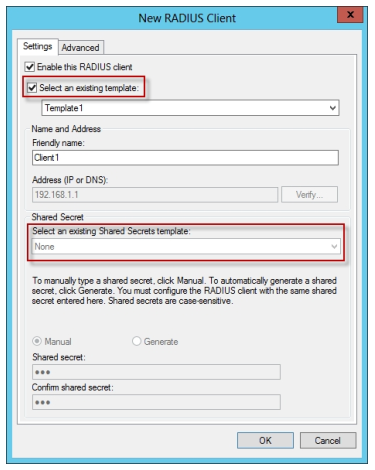
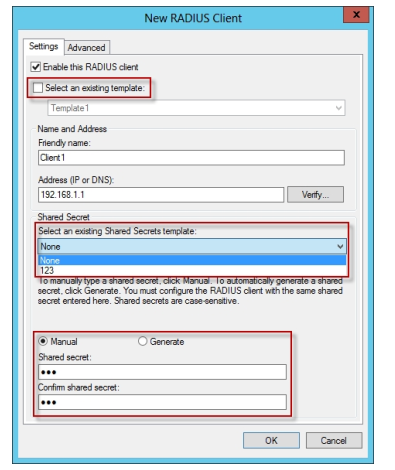
Question No : 8 – (Topic 0) Your network contains an Active Directory domain named contoso.com. All servers run Windows Server 2012 R2. The domain contains a server named Server1 that has the Network Policy Server server role and the Remote Access server role installed. The domain contains a server named Server2 that is configured as a RADIUS server. Server1 provides VPN access to external users. You need to ensure that all of the VPN connections to Server1 are logged to the RADIUS server on Server2. What should you run?
A. Add-RemoteAccessRadius -ServerNameServer1 -AccountingOnOffMsg Enabled – SharedSecret “Secret” -Purpose Accounting
B. Set-RemoteAccessAccounting -AccountingOnOffMsg Enabled -AccountingOnOffMsg Enabled
C. Add-RemoteAccessRadius -ServerName Server2 -AccountingOnOffMsg Enabled – SharedSecret “Secret” -Purpose Accounting
D. Set-RemoteAccessAccounting -EnableAccountingType Inbox -AccountingOnOffMsg Enabled
Answer: C
Explanation:
Add-RemoteAccessRadius
Adds a new external RADIUS server for VPN authentication, accounting for DirectAccess (DA) and VPN, or one-time password (OTP) authentication for DA.
AccountingOnOffMsg<String>
Indicates the enabled state for sending of accounting on or off messages. The acceptable values for this parameter are: Enabled. Disabled. This is the default value. This parameter is applicable only when the RADIUS server is being added for Remote Access accounting.
Question No : 9 – (Topic 0)
Your network contains four Network Policy Server (NPS) servers named Server1, Server2, Servers, and Server4. Server1 is configured as a RADIUS proxy that forwards connection requests to a remote RADIUS server group named Group1. You need to ensure that Server2 and Server3 receive connection requests. Server4 must only receive connection requests if both Server2 and Server3 are unavailable. How should you configure Group1?
A. Change the Weight of Server4 to 10.
B. Change the Weight of Server2 and Server3 to 10.
C. Change the Priority of Server2 and Server3 to 10.
D. Change the Priority of Server4 to 10.
70-411 vce Answer: D
Explanation: During the NPS proxy configuration process, you can create remote RADIUS server groups and then add RADIUS servers to each group. To configure load balancing, you must have more than one RADIUS server per remote RADIUS server group. While adding group members, or after creating a RADIUS server as a group member, you can access the Add RADIUS server dialog box to configure the following items on the Load Balancing tab: Priority. Priority specifies the order of importance of the RADIUS server to the NPS proxy server. Priority level must be assigned a value that is an integer, such as 1, 2, or 3. The lower the number, the higher priority the NPS proxy gives to the RADIUS server. For example, if the RADIUS server is assigned the highest priority of 1, the NPS proxy sends connection requests to the RADIUS server first; if servers with priority 1 are not available, NPS then sends connection requests to RADIUS servers with priority 2, and so on. You can assign the same priority to multiple RADIUS servers, and then use the Weight setting to load balance between them.
Weight. NPS uses this Weight setting to determine how many connection requests to send to each group member when the group members have the same priority level. Weight setting must be assigned a value between 1 and 100, and the value represents a percentage of 100 percent. For example, if the remote RADIUS server group contains two members that both have a priority level of 1 and a weight rating of 50, the NPS proxy forwards 50 percent of the connection requests to each RADIUS server. Advanced settings. These failover settingsprovide a way for NPS to determine whether the remote RADIUS server is unavailable. If NPS determines that a RADIUS server is unavailable, it can start sending connection requests to other group members. With these settings you can configure the number of seconds that the NPS proxy waits for a response from the RADIUS server before it considers the request dropped; the maximum number of dropped requests before the NPS proxy identifies the RADIUS server as unavailable; and the number of seconds that can elapse between requests before the NPS proxy identifies the RADIUS server as unavailable. The default priority is 1 and can be changed from 1 to 65535. So changing server 2 and 3 to priority 10 is not the way to go.
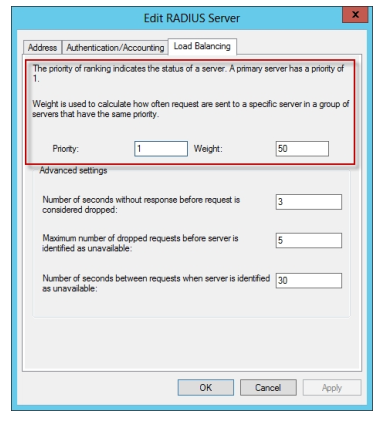
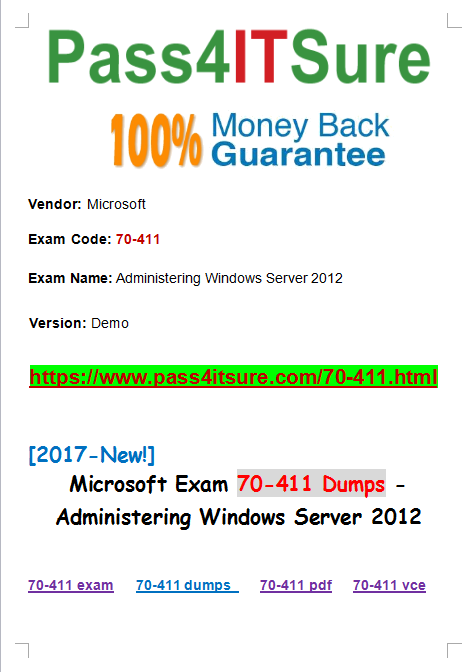
If you have a faith, then go to defend it. Gorky once said that faith is a great emotion, a creative force. My dream is to become a top IT expert. I think that for me is nowhere in sight. “Administering Windows Server 2012”, also known as 70-411 exam, is a Microsoft certification which covers all the knowledge points of the real Microsoft exam. Pass4itsure Microsoft 70-411 dumps exam questions answers are updated (234 Q&As) are verified by experts. The associated certifications of 70-411 dumps is MCP, MCSA, MCSE. But to succeed you can have a shortcut, as long as you make the right choice. I took advantage of Pass4itsure’s Microsoft https://www.pass4itsure.com/70-411.html dumps exam training materials, and passed the Microsoft 70-411 dumps exam.